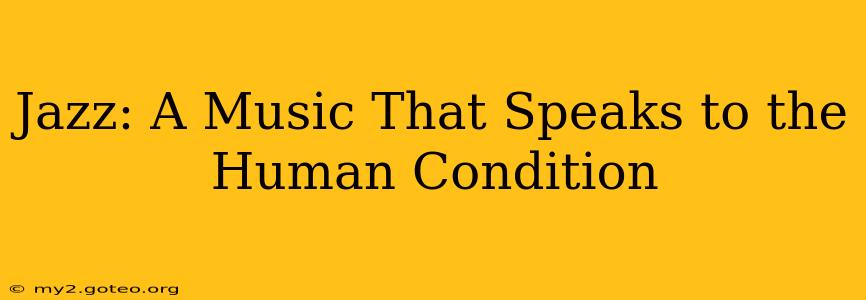Jazz. The very word conjures images of smoky clubs, improvisational solos, and a unique blend of joy and melancholy. But jazz is far more than just a genre of music; it's a reflection of the human condition, a vibrant tapestry woven from threads of struggle, resilience, innovation, and profound emotional expression. This exploration delves into the heart of jazz, examining its historical context, its technical aspects, and its enduring impact on the world.
What Makes Jazz Unique?
Jazz's uniqueness lies in its improvisational nature. Unlike classical music, which adheres strictly to written scores, jazz musicians often improvise melodies and harmonies spontaneously, creating a dynamic and ever-evolving musical experience. This improvisation isn't random; it's rooted in a deep understanding of musical theory, harmony, and rhythm, allowing for creative freedom within structured frameworks. The collective improvisation, where multiple musicians interact and respond to each other in real-time, further distinguishes jazz from other genres. This interplay creates a conversation, a musical dialogue that mirrors human interaction itself.
How Did Jazz Originate?
Jazz's roots are deeply intertwined with the African American experience in the United States. Emerging in the late 19th and early 20th centuries, primarily in New Orleans, it blended elements of African rhythms, European harmonies, and blues music. The unique social and cultural context of the time—segregation, hardship, and the yearning for self-expression—fueled the explosive creativity of early jazz pioneers. This fusion of influences is evident in the genre's diverse range of styles, from the ragtime of Scott Joplin to the swing of Count Basie.
What are the Different Styles of Jazz?
The evolution of jazz has resulted in a multitude of distinct subgenres, each with its own unique characteristics. Some of the most prominent styles include:
- Dixieland: Characterized by collective improvisation and a strong emphasis on group interaction.
- Swing: Known for its danceable rhythms and big-band arrangements.
- Bebop: A more complex and improvisational style featuring rapid tempos and intricate harmonies.
- Cool Jazz: A reaction against bebop's intensity, emphasizing a smoother, more relaxed sound.
- Modal Jazz: Focuses on melodic improvisation within specific modes or scales.
- Free Jazz: Emphasizes total improvisation, often abandoning traditional harmonic structures.
- Fusion: A blend of jazz with other genres, such as rock, funk, and Latin music.
Understanding these diverse styles helps to appreciate the breadth and depth of the jazz tradition.
What are the Key Instruments in Jazz?
While the instrumentation varies depending on the style of jazz, certain instruments are central to the genre's sound. The saxophone, trumpet, trombone, piano, double bass, and drums are frequently featured. Each instrument contributes a unique texture and voice to the musical conversation, creating a richly layered sonic landscape.
How Does Jazz Reflect the Human Condition?
Jazz, with its improvisational nature and emotional depth, serves as a potent mirror reflecting the human experience. The highs and lows, the joy and sorrow, the struggle and triumph—all are expressed through the music. The very act of improvisation is a testament to human creativity and adaptability. The collaborative nature of jazz underscores the importance of connection and community. The emotional intensity of a powerful solo reflects the inner turmoil and passions of the human heart. Jazz is not simply entertainment; it's a profound expression of the human spirit.
Is Jazz Still Relevant Today?
Absolutely. While its origins lie in the early 20th century, jazz continues to evolve and inspire musicians worldwide. Contemporary jazz artists are pushing boundaries, blending traditional elements with new sounds and technologies. The genre's enduring appeal lies in its capacity for emotional expression, its intellectual stimulation, and its capacity for continuous reinvention. It remains a vital and relevant art form, speaking to the complexities of the human condition in a language that transcends time and culture.
Where Can I Learn More About Jazz?
Numerous resources are available for those seeking to delve deeper into the world of jazz. Explore online archives of recordings, documentaries, and biographies of influential musicians. Attend live jazz performances, both in established venues and smaller, intimate settings. Engage with the vibrant jazz community through online forums and social media groups. The journey of discovery is as rich and varied as the music itself.
This exploration only scratches the surface of this rich and complex musical tradition. Jazz is a journey of continuous discovery, a testament to human creativity and resilience, and a timeless expression of the human condition.

